Fire Detection System
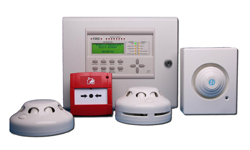 Fire detection systems are designed to discover fires early in their development when time will still be available for the safe evacuation of occupants. Early detection also plays a significant role in protecting the safety of emergency response personnel. Property loss can be reduced and downtime for the operation minimized through early detection because control efforts are started while the fire is still small.
Fire detection systems are designed to discover fires early in their development when time will still be available for the safe evacuation of occupants. Early detection also plays a significant role in protecting the safety of emergency response personnel. Property loss can be reduced and downtime for the operation minimized through early detection because control efforts are started while the fire is still small.
Most alarm systems provide information to emergency responders on the location of the fire, speeding the process of fire control.
To be useful, detectors must be coupled with alarms. Alarm systems provide notice to at least the building occupants and usually transmit a signal to a staffed monitoring station either on or off site. In some cases, alarms may go directly to the fire department, although in most locations this is no longer the typical approach.
These systems have numerous advantages as discussed above. The one major limitation is that they do nothing to contain or control the fire.
Fire Pump
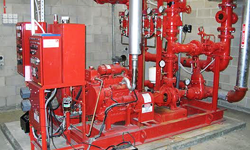 A fire pump is any kind of pump that is part of a fire protection system's water supply. It is important to know that a fire pump does not create water, it takes water that is given to it from a water supply and increases the pressure of the water.
A fire pump is any kind of pump that is part of a fire protection system's water supply. It is important to know that a fire pump does not create water, it takes water that is given to it from a water supply and increases the pressure of the water.
A fire pump can be powered by electric, diesel and can supply fire sprinklers, standpipes, foam systems, water spray/mist systems or any combination of these systems. The fire pump’s intake is usually connected to the external water supply, although in some cases it may be connected to a local water source such as a well, tank, or body of water.
Fire pumps are needed when the water supply cannot provide sufficient pressure to meet the hydraulic design requirements of the fire protection system. This usually occurs if the building is very tall, such as in high-rise buildings, or in systems which require a relatively high terminal pressure at the fire sprinkler in order to flow a large volume of water, such as in storage warehouses. Fire pumps are also needed if the water supply is provided from a ground level water storage tank.
Types of pumps used for fire service include: horizontal split case, vertical split case, vertical inline, vertical turbine, and end suction.
Central Battery System
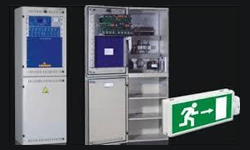 A Central Battery System for Emergency Lighting means that the backup power source for the Emergency and Exit Lights is provided centrally. In other words, each Emergency and Exit Light does not need to have a battery or super capacitor of their own. A Central Battery System is often perceived as a solution for large buildings and sites.
A Central Battery System for Emergency Lighting means that the backup power source for the Emergency and Exit Lights is provided centrally. In other words, each Emergency and Exit Light does not need to have a battery or super capacitor of their own. A Central Battery System is often perceived as a solution for large buildings and sites.
Central battery system based emergency lighting is ideal for medium to large installations. For projects where central control and testing is desirable, a central battery system is a viable and cost effective alternative to self-contained emergency lighting products.
The main advantages of central battery systems over self-contained systems are:
• Testing and maintenance is much easier to carry out
• Battery replacement is much quicker and less disruptive
• Battery life is generally 10 years or more
• Luminaires can be centrally controlled
• High light levels can easily be achieved
• The emergency lighting system can be completely unobtrusive.
A Central Battery System for Emergency Lighting means that the backup power source for the Emergency and Exit Lights is provided centrally. In other words, each Emergency and Exit Light does not need to have a battery or super capacitor of their own.
A Central Battery System is often perceived as a solution for large buildings and sites
A Central Battery System has a couple of advantages over a self-contained Emergency Lighting System. Since there are no batteries or super capacitors in the luminaires themselves, there are less components to maintain and service. This truly pays off, when the natural life span of the batteries is coming to an end. With a Central Battery System, the replacement of the batteries can be done in one location, in contrast to Self-Contained Emergency and Exit Lights, where the batteries must be replaced one-by-one, in each luminaire.
Sprinkle System
There are basically four types of fire sprinkler systems:
Wet Pipe Fire Sprinkler Systems –
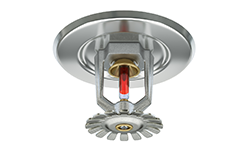
wet pipe fire sprinklers are the most common type of fire sprinkler system in use. In a wet pipe fire sprinkler, the water is stored directly in the pipes and released by heat activated sprinkler heads. This type of fire sprinkler has the advantage of being able to activate instantly, with no lag time when the fire sprinkler heads open.
Dry Pipe Fire Sprinkler Systems –
dry pipe fire sprinkler systems are similar to wet pipe, except the water is not stored in the pipes. Instead, the pipes are filled with pressurized air or nitrogen gas. When the sprinkler heads open, the gas is released and a valve opens that allows water to flow out through the open fire sprinkler heads. While this causes a slight delay in water discharge, it is useful in buildings where water could freeze if kept in the pipes.
Deluge Fire Sprinkler Systems –
a deluge fire sprinkler system is very similar to a wet pipe fire sprinkler system, except the fire sprinkler heads are kept open at all times – they are not activated by heat. Instead, deluge fire sprinkler systems are operated by a specialized fire alarm which causes a valve to open and release the water. Once the valve opens, it can’t be closed until manually turned off.
Deluge fire sprinklers are not commonly found in homes or offices. Instead, they are used in places where rapid fire spread is a concern. You will usually see deluge fire sprinkler systems near high rise windows, warehouse bay entries or anywhere else where a fire could escape quickly.
Pre-Action Fire Sprinkler Systems –
a pre-action fire sprinkler system is basically a combination of wet pipe and dry pipe fire sprinkler system. Basically, water is not stored in the pipes until a fire detection device detects a fire. At this point, the detection device opens a valve to let the water in before the sprinkler heads open. When the heads open, the pre-action fire sprinkler system reacts as quickly as a wet pipe fire sprinkler system.
Pre-action fire sprinkler systems are best suited for areas that are at high risk for serious water damage in the event of accidental fire sprinkler activation.
Central Battery System
dA Central Battery System for Emergency Lighting means that the backup power source for the Emergency and Exit Lights is provided centrally. In other words, each Emergency and Exit Light does not need to have a battery or super capacitor of their own.
A Central Battery System is often perceived as a solution for large buildings and sites
A Central Battery System has a couple of advantages over a self-contained Emergency Lighting System. Since there are no batteries or super capacitors in the luminaires themselves, there are less components to maintain and service. This truly pays off, when the natural life span of the batteries is coming to an end. With a Central Battery System, the replacement of the batteries can be done in one location, in contrast to Self-Contained Emergency and Exit Lights, where the batteries must be replaced one-by-one, in each luminaire.
Clean Agent System:-
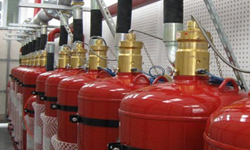
Clean Agent Fire Protection System, which includes the use of HFC-227ea and FM-200, leaves no residue and doesn't require costly clean-up, unlike sprinklers and other fire protection systems. And it discharges in 10 seconds or less, extinguishing a fire quickly and effectively.
When you are trying to protect critical assets such as IT systems, data storage rooms and manufacturings equipments, or irreplaceable items like customer/client records, intellectual property, art, antiques and artifacts – using water will just compound the damage. Using a Clean Agent fire suppression system in this case is the best solution.
Novec 1230, FM-200 and Argonite are the preferred Clean Agent fire suppression systems of Approved Protection Systems.
There are 3 ways clean agents can extinguish a fire:
Reduction of heat (FM-200, Novec 1230)
Reduction or isolation of oxygen (Argonite)
Inhibiting the chain reaction of the above components (FM-200)
Advantages:
Fast
Clean Agent systems reach extinguishing levels in 10seconds or less!
Effective
Clean Agents are designed to control and extinguish a fire in its incipient stage – before it has a chance to spread. Clean Agents are electrically non-conductive and non-corrosive, and there will be no damage to electronics and delicate mechanical devices.
Safe
Clean Agents are designed to provides a wide margin of human safety – they are safe to use where people are present.
Earth Friendly
Clean Agents are non ozone depleting and have a short atmospheric lifetime.
Wet Chemical System- Kitchen hood
 Wet Chemical Fire Suppression Kitchen System offers 24-hour automatic or manual protection for commercial cooking areas; ducts, plenums, hoods and cooking surfaces. The wet chemical agent is designed for quicker flame knockdown and faster suppression.
Wet Chemical Fire Suppression Kitchen System offers 24-hour automatic or manual protection for commercial cooking areas; ducts, plenums, hoods and cooking surfaces. The wet chemical agent is designed for quicker flame knockdown and faster suppression.
Wet Chemical Kitchen System is a cost-effective, pre-engineered fire protection solution designed for a quick and easy installation. The system offers unmatched coverage, with fewer discharge nozzles and flow points than the competition, meaning reduced installation time and cost. It exceeds stringent UL 300 standard and complies with NFPA Standards 96 and 17A.
Features
Safe and reliable fire protection
Ease of design and flexibility of installation
Flexibility and reliability of important safety system
Fire Extinguishers
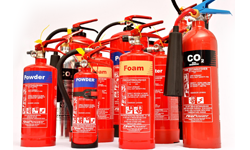 A fire extinguisher is an active fire protection device used to extinguish or control small fires, often in emergency situations. It is not intended for use on an out-of-control fire, such as one which has reached the ceiling, endangers the user (i.e., no escape route, smoke, explosion hazard, etc.).
A fire extinguisher is an active fire protection device used to extinguish or control small fires, often in emergency situations. It is not intended for use on an out-of-control fire, such as one which has reached the ceiling, endangers the user (i.e., no escape route, smoke, explosion hazard, etc.).
Types of extinguishers
Water extinguishers. Water extinguishers are one of the most cost-effective ways to fight Class A fires, those fuelled by solid materials such as paper, wood and textiles. ...
Powder extinguishers.
Carbon dioxide extinguishers (CO2).
Wet chemical extinguishers.
Fire blankets.

Interior Fit out Works
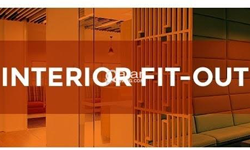 We Undertake Turnkey projects, Major fitout & MEP Projects concerning fire detection and fire protection systems in accordance with the relevant UAE Fire & Life Safety Code.
We Undertake Turnkey projects, Major fitout & MEP Projects concerning fire detection and fire protection systems in accordance with the relevant UAE Fire & Life Safety Code.
Water Mist System
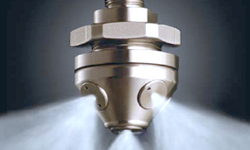 A water mist system is a fire protection system which uses very fine water sprays (i.e. water mist). The small water droplets allow the water mist to control, suppress or extinguish fires by: cooling both the flame and surrounding gases by evaporation. displacing oxygen by evaporation.
A water mist system is a fire protection system which uses very fine water sprays (i.e. water mist). The small water droplets allow the water mist to control, suppress or extinguish fires by: cooling both the flame and surrounding gases by evaporation. displacing oxygen by evaporation.
Deluge Fire Suppression System
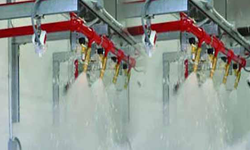 A deluge fire sprinkler system is similar to a pre-action system except the sprinkler heads are open and the pipe is not pressurized with air. Deluge systems are connected to a water supply through adeluge valve that is opened by the operation of a smoke or heat detection system.
A deluge fire sprinkler system is similar to a pre-action system except the sprinkler heads are open and the pipe is not pressurized with air. Deluge systems are connected to a water supply through adeluge valve that is opened by the operation of a smoke or heat detection system.
Voice Evacuation System
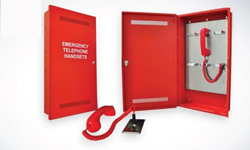 Audible textual appliances, which are employed as part of a fire alarm system that includes Emergency Voice Alarm Communications (EVAC) capabilities. High-reliability speakers are used to notify the occupants of the need for action in connection with a fire or other emergency.
Audible textual appliances, which are employed as part of a fire alarm system that includes Emergency Voice Alarm Communications (EVAC) capabilities. High-reliability speakers are used to notify the occupants of the need for action in connection with a fire or other emergency.
These speakers are employed in large facilities where general undirected evacuation is considered impracticable or undesirable. The signals from the speakers are used to direct the occupant's response. The system may be controlled from one or more locations within the building known as Fire Wardens Stations, or from a single location designated as the building Fire Command Center.
Speakers are automatically actuated by the fire alarm system in a fire event, and following a pre-alert tone, selected groups of speakers may transmit one or more prerecorded messages directing the occupants to safety.
These messages may be repeated in one or more languages. Trained personnel activating and speaking into a dedicated microphone can suppress the replay of automated messages in order to initiate or relay real-time voice instructions.
Annual Maintenance Contract
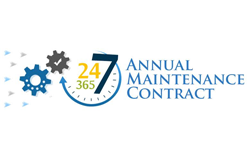 FirePro Services team is a group of skilled, trained engineers & technicians who undertake a Quarterly Service Schedule for AMC customers to ensure that every device in the client’s premises is always working optimally.
FirePro Services team is a group of skilled, trained engineers & technicians who undertake a Quarterly Service Schedule for AMC customers to ensure that every device in the client’s premises is always working optimally.
Extra Low Voltage System
 Firepro Star is specilized for tendering and executing all sort of Extra Low Voltage works with SIRA guidelines and approval,
Firepro Star is specilized for tendering and executing all sort of Extra Low Voltage works with SIRA guidelines and approval,
Our Specialization are as follows;
CCTV System
Public Address /Music System
IT Software and Hardware System Integration
POS System
Access Control System
Security Alaram System
HVAC System Works
Electrical Works
Plumbing Works